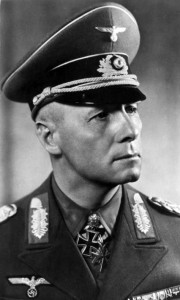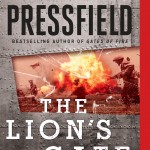Most of Steven Pressfield’s war novels take place in the distant past; Killing Rommel takes place more recently, in the North African desert during the World War II British campaign against the Germans. Germany’s Afrika Korps was commanded by Field Marshal Erwin Rommel, the “Desert Fox“; a highly decorated veteran of World War I, Rommel was one of the most skilled commanders on either side of the war, and defeating him took the combined efforts of General George S. Patton, Field Marshall Montgomery, and (ultimately) Hitler himself—Rommel was implicated in the plot to assassinate Hitler, and in 1944 Hitler forced him to take poison.

Pressfield’s book purports to be the posthumous war memoirs of a British publisher named R. Lawrence Chapman, and is set in the years 1942 and 1943. (No Rommels are in fact killed in this book.) A tank officer, Chapman is seconded to a unit called the Long Range Desert Group. The LRDG is what we’d now call a “special forces” unit, tasked to infiltrate behind enemy lines and there to conduct all kinds of sabotage and other merriment.
In North Africa, infiltrating was both easy and hard, and for the same reason. The habitable zone in North Africa extends only a small distance from the shore; in order to infiltrate, all the LRDG needed to do was travel south into the deep desert, proceed east or west, as it might be, and then travel north again. Easily said; not easily done. The deep Sahara is one of the most inhospitable regions of the world.
The mission of the Long Range Desert Group was raiding and reconnaissance in the enemy’s rear. At the time I joined it, the unit operated in patrols of five or six trucks, with one officer and fifteen to twenty men. Patrols were entirely self-contained, carrying all their own petrol, water, rations, ammunition and spare parts. In addition to its own combat operations, the Long Range Desert Group conveyed spies and agents on covert assignments and provided transport and navigation for assault parties of the SAS and other commando outfits. The group’s greatest joy, however, was to work “beat-ups,” their slang term for attacks on enemy airfields, motor assembly areas and convoy routes.
Shortly after Chapman joins his new unit, the LRDG is given the mission of killing Rommel:
Rommel was notorious among his own junior officers, we were told, for materialising unannounced at forward positions, stepping down from his Fieseler Storch scout plane or his “Mammoth” Armoured Command Vehicle, occasionally from a tank or a staff car or even a motorcycle upon which he had hitched a ride. It was not exceptional for Rommel to issue orders directly to his regimental commanders or even, in the heat of the moment, to take personal command of units as small as infantry companies.
Such boldness had nearly got Rommel killed more than once. He set his plane down by accident one time amongst an Allied formation and winged away, barely, with bullets whizzing round his head. Another time he escaped capture when he ran out of fuel on the frontier wire, again amidst Commonwealth troops. Rommel was rescued a third time by the staff car carrying one of his own generals who happened, emulating his mentor, to be as far forward as Rommel was.
Rommel’s trademark aggressiveness, it was hoped, could render him vulnerable to a surprise thrust. If Allied raiders could use the deep desert routes to move undetected into the German rear; if they could manoeuvre forward undiscovered; if they could fix Rommel’s position…if a skilled and daring party could do all this, they might be able to land a blow that would change the course of the war.
And the rest of the book is Chapman’s story: a highly detailed, endlessly fascinating look and (sometimes excruciatingly) personal look at war in the desert. Chapman himself is fictitious, but the LRDG and most of the people Chapman meets in it were quite real; Pressfield has done his usual bang-up job of research. In the end, though, this is not simply a book about war; it’s a book about war between men of honor, and honor is a continual theme. All of the combatants in North Africa were accustomed to salvaging the abandoned and damaged vehicles of their enemies, so much so that when Rommel’s army came and surrounded Chapman’s truck, which had been camped (as they thought) in the middle of nowhere, Chapman and his men were able to quietly travel with Rommel’s forces for several days, just by doing what everyone else was doing. It was an English truck, but it hardly mattered. At the same time, there were limits: one might look through abandoned vehicles for tobacco, alcohol, food, or other supplies, but one stopped short at looting the pockets of the dead.
The book’s logic ultimately leads Chapman to an encounter with Field Marshall Rommel: an encounter that never happened, though it very while might have, and one that I found unexpectedly moving. War is an a ugly business, but it need not be dehumanizing. Highly recommended.
I might add: I gave it to my eldest son, the budding history buff, last week; he devoured it.
____
Photo Credit: Bundesarchiv, Bild 146-1973-012-43 / CC-BY-SA











